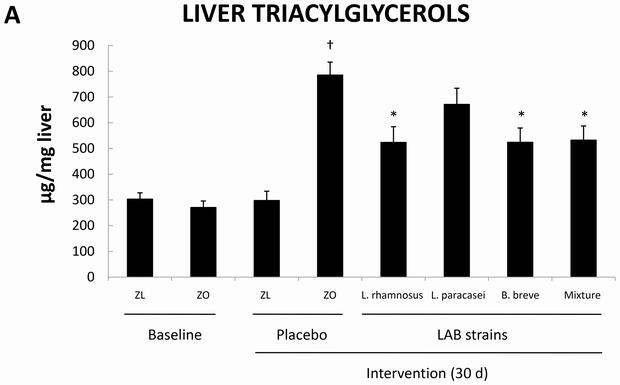Spanish scientists did an experiment using obese rats and found that the consumption of probiotics over 30 days (equivalent to almost four years in human terms) helped diminish the accumulation of fat in the liver.
The researchers from the Nutrition Biochemistry: Theurapetic Applications group (CTS-461) and the José Mataix Institute for Nutrition and Food Technology at the University of Granada administered three probiotic strains to Zucker rats. These rats develop obesity due to a mutation in the gene that codifies the receptor or leptine, a hormone that transmits a sensation of satiety to the organism.
Zucker rats are among the best characterized genetic models so their finding that probiotics diminishes the accumulation of fat in the liver of obese rats would be a great step forward on the fight agains the Non-Alcolohic Fatty Liver Disease (NAFLD), which is closely related to obesity and diabetes.
Probiotics have also been reported to lower the hepatic TG and cholesterol content in mice and rats with high fat diet-induced obesity and they are safe, but that could be because they really aren't doing anything. There are so many confounding factors and none of these products have been clinically tested in humans because the worst thing that can happen to the booming market is proof they don't work. There are trillions of bacteria, yeasts and other microbes in the human gut so the amount of probiotic yogurt needed to help in that may be beyond human capability.
The accumulation of fat in the liver is called steatosis and it constitutes the first stage in the NAFLD disease, which is closely related to obesity and diabetes. Given that the prevalence of these two pathologies does not cease to increase, NAFLD has also become a health problem that affects millions of people throughout the world.
Living or dead microorganisms
Probiotics are microorganisms (bacteria or yeasts) with healthy effects upon individuals that consume them in adequate doses. They were traditionally considered to be living microorganisms, but the concept was widened since some dead microorganisms, or even their components, can display probiotic properties.
University of Granada researchers worked with three strains which are custodied at the Collection Nationale de Cultures de Microorganismes (CNCM) of the Pasteur Institute: Lactobacillus paracasei CNCM I-4034, Bifidobacterium breve CNCM I-4035 and Lactobacillus rhamnosus CNCM I-4036. During their first experiment, conducted on healthy volunteers, researchers demonstrated that all three of them are perfectly tolerable and safe for human consumption.
In their article, the authors describe that the administration of probiotics led to an accumulation of lipids (most of them triacylglycerides) in the liver which was significantly lower than that occurring in rats fed with a placebo.

Liver triacylglycerol content of Zucker-lean+/fa and Zucker-Leprfa/fa rats that were fed either a placebo or LAB strains for 30 days. Values are the means ± SEM, n = 8 per group. †P<0.05 (ZL + placebo vs. ZO + placebo), and *P<0.05 (ZO + placebo vs. ZO + LAB strains). ZL, Zucker-lean+/fa rats; ZO, Zucker-Leprfa/fa rats.
"This new finding went hand in hand with lower values in proinflamatory molecules (tumor-a necrosis factor, interleukin 6 and liposacarid) in the serum of rats fed with probiotics. These effects were not observed in those
According to these researchers, this liver disease will not be cured with probiotics, but these microorganisms can certainly be used as support therapy in joint use with other treatment.





Comments